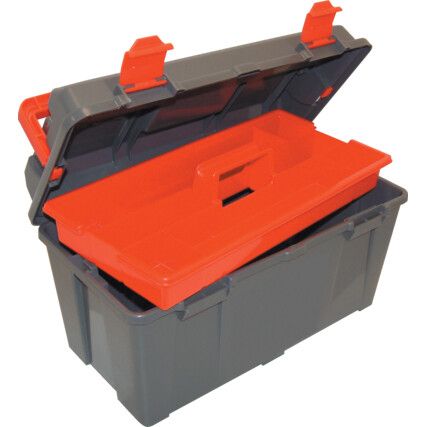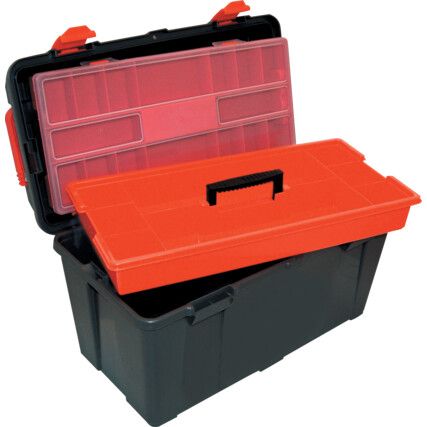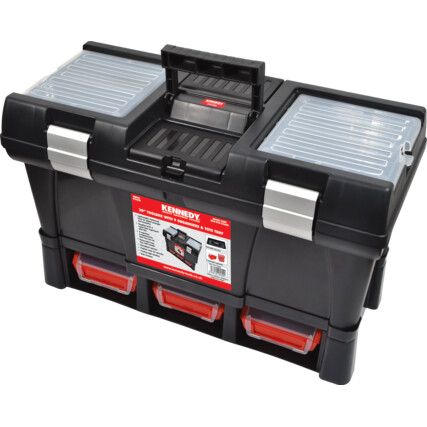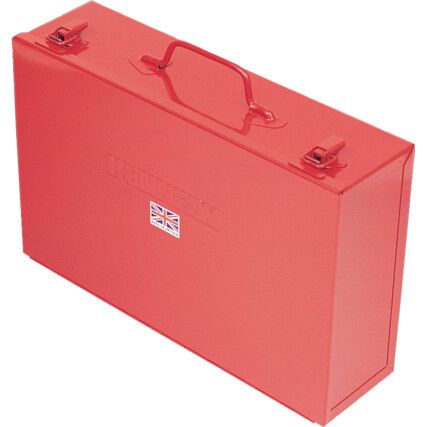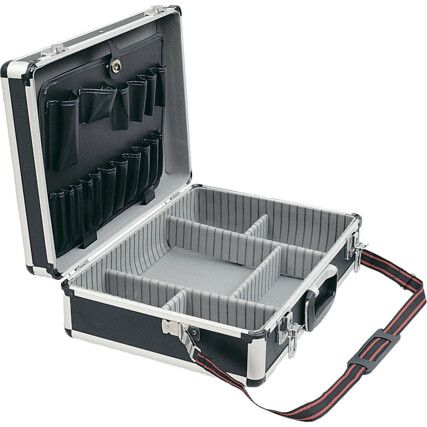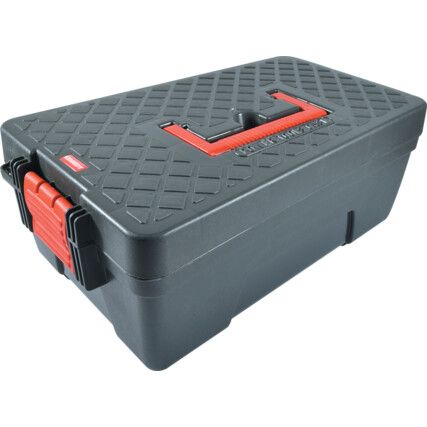Cutii pentru unelte
Hand tools can be costly items, so naturally, keeping them in tip top working order, organised and secure is important. A toolbox is the ideal way to store tooling items as well as allowing for portability for on-site jobs. From small plastic storage options holding a couple of items, to large metal toolboxes with multiple compartments capable of storing and transporting a myriad of tools, you're bound to find something in the Cromwell range of toolboxes that suits your requirements.
What are toolboxes?
Toolboxes are durable, portable boxes with excellent storage facilities for a wide variety of tools.
Why Toolboxes?
Tooling left lying around is not only likely to get lost or misplaced (a real thorn in the side when you lose a specific sized tool from a set) not to mention carting around tools from job to job can increase the risk of loss if you haven't someplace to store them in transit. Tools ineffectively stored can also be exposed to the elements which could cause lasting damage in the form of rust and chemical corrosion from liquid spillages etc.
Organisation is another benefit of storing your hand tools in a toolbox. Most toolboxes feature a multitude of storage options making tool selection more efficient. Many toolboxes feature compartments for smaller components that have more of a tendency to get lost in busy work environments as well as spacious main compartments for larger hand tools, helping you keep everything you need in one place.
Security is also an advantage of owning a toolbox. From keeping your tools in place during transit to helping avoid items "disappearing", investing in a quality toolbox will help ensure tools are kept safe. Certain types of toolboxes come with the added addition of being lockable, ensuring that your tooling is secure and a less likely to attract unwanted attention.
When are toolboxes used?
Toolboxes are used on most jobs requiring any type of tool, as they are an easy and safe way to transport your tools.
Toolbox types
There are many different types of toolboxes, made from a multitude of different materials and all suitable for varying different applications. From everyday domestic toolboxes to heavy duty industrial and professional tool storage solutions, it helps to know the types of toolboxes and their benefits before choosing one that's right for your needs.
The material that the toolbox is made from can have significant impact of the way that it can be used. To help weigh up which is the right material for you Cromwell has outlined the most common material types below.
• Plastic toolboxes These are durable and lighter weight, making them the ideal for domestic home tool storage or for on-site jobs where portability is key. They also have one advantage over metal toolboxes in that they are not susceptible to corrosion, which can be an issue in environments where moisture is likely to collect. Industrial grade high impact plastics allow for greater durability with greater mobility (thanks to less weight) and are an increasingly cost-effective tool storage solution. One final advantage of a plastic or high impact polymer-based toolbox is the ability to have transparent elements, allowing the user to see the certain contents before opening, allowing for more convenient and quicker tool selection.
• Metal toolboxes These tend to come in three main materials aluminium, steel, and stainless steel. Metal has the added advantage of durability over high impact plastic, polypropylene, and other polymer-based toolboxes, albeit this strength advantage is traded off with a typically heavier weight.
• Aluminium These tends to have a lighter weight than its steel counterparts and has a natural resistance to corrosion and is known to resist rusting, even when exposed to water for long periods of time. Its lighter weight allows for greater portability than heavier metals, however it may be a tad more susceptible to dents and dings than its harder metal counterparts.
• Steel is a hard and durable metal and as a result, toolboxes made from steel are hard wearing and incredibly durable, more so than aluminium, however this comes with the trade-off of a heavier weight meaning less portability. Steel toolboxes are ideally used for heavy tooling and stationary tool storage solutions, such as mechanics toolboxes where strength and durability outweigh portability.
• Stainless Steel is the third and hardest wearing of the three main types of metal toolboxes, it has the advantage of increased endurance over both regular steel and aluminium, with increased resistance to rust. The trade off with stainless steel is that it comes with the same added weight as steel (so less portable) and a higher price point, but with stainless steel usually you will end up with a toolbox that could potentially last a lifetime.
Toolbox considerations
The design of the toolbox is a key consideration in choosing the correct box to store your tools. This will depend heavily on the nature of the work you undertake, for example are you typically travelling to job sites? Are you based in a workshop most of the time? And how many tools do you need to store?
• Handheld or carry handle toolboxes - These come in a range of materials and usually feature a carry handle attached to the lid of the toolbox. Typically (but not always) they are fastened by latches allowing you to open the main storage compartment. Some of these types of toolboxes feature interior removable storage trays to help organise tools and keep them secure in transit.
• Cantilever toolboxes - A great space saving solution as well as keeping your tools well organised. They typically feature two to four, fold out trays and a large main compartment. This design allows you to store specific tools in certain trays for easier access as well as avoiding piling your tools on top of one another and risking damage. Usually featuring a carry handle, they are good for portability and keeping organised on the go.
• Stationary toolboxes - Ideal for large tool collections in workshop areas. They can feature drawer designs for the ideal tool organisation, some models feature stackable systems allowing more storage to be added as you acquire more tools. The downside of this design is that portability is an issue unless mounted on a separate roller trolley system.
• Roller toolbox systems - These are usually mounted on a trolley system or have their own inbuilt wheels allowing for easy manoeuvrability and portability. They are usually large in capacity, and some have a modular stack system allowing you to add additional storage to the unit. Because of their bulk they are less portable than handheld toolboxes, but they counter this with the additional tool storage that they incorporate.
Toolbox jargon buster
• Cantilever - A fold out tray system attached to struts that allows all compartments of the toolbox to be accessible at once.
• Tote tray - A removable tray, with compartments for a selection of tools. Ideal for when the job required multiple tools within easy reach.
FAQs
What are toolboxes made from?
Toolboxes can be made from many materials, traditionally they were made from wood, however with modern manufacturing toolboxes are now typically manufactured from polymers or metal. Polymer-based materials such as high-impact plastic, polypropylene and other lightweight high-density materials are excellent for making toolboxes as they combine toughness with less weight. Metal toolboxes can be manufactured from aluminium, steel, and stainless steel, they provide greater toughness than polymers but at the trade off with weight. Most metal toolboxes are treated with a rust-proof coating to help limit the risk of corrosion over time.
What are good toolboxes for domestic applications?
It depends on the application primarily. As an everyday household toolbox a plastic toolbox will be more than sufficient, if you're needs venture towards hobbies and automotive applications then consider a metal cantilever toolbox, or maybe even a modular system if you're going to need to house a large number of tools.
Can toolboxes be used to house powertools?
Yes, they can but you should consider size and weight when deciding. A small lightweight plastic toolbox for example wouldn't be ideal for housing items like a heavy-duty hand drill.
